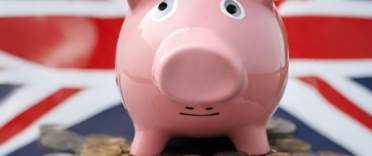The 122nd episode of my weekly YouTube show where I discuss what is happening in investment markets and what to look out for. This week I talk about how the pound is tumbling as bond yields burst higher
Each show lasts between 5-10 minutes and is aimed at DIY investors (including novices) seeking contemporary analysis to help them understand how investment markets work.
Subscribe to my YouTube channel to receive my weekly analysis of investment markets or alternatively, you can listen via my weekly Midweek Markets podcast below.
Midweek Markets weekly podcast
Other ways to watch, listen and subscribe
You can listen to other episodes and subscribe to the show by searching 'Money to the Masses' on Spotify or by using the following links:
Abridged transcript - Midweek Markets episode 122
I closed the last Midweek Markets show, which was two weeks ago, by stating that UK and US markets would likely gain more certainty next week when the Bank of England and the Fed’s policy meetings occurred on the 23rd and 22nd of September respectively. My parting comment was that things could get interesting.
Back then the S&P 500 was trading at 4480 but has since fallen 3%, only to recover those losses to then pullback once more and now sits at 4350.
In the UK the FTSE 100 has been on an equivalent rollercoaster ride, but is around about 1% higher than the 7000 level it was at two weeks ago, partly boosted by a tumbling pound which I will come on to later.
We’ve also seen similar levels of increased volatility in European, Asian and emerging market stock markets. So what has been going on? Well in truth a number of factors. The first shockwave emanated from the Chinese property market in the shape of Evergrande.
Evergrande Group is China’s second-largest real estate developer and in 2018, it became the world’s most valuable property company.
Evergrande currently oversees more than 1,300 projects in almost 300 cities across China, but also boasts other business segments ranging from wealth management, electric vehicles, food and drinks manufacturing.
However, Evergrande shook bond and equity markets after it was reported to be struggling to meet the interest payments on its debts, which total a staggering $300 billion. The company had previously borrowed huge sums to expand aggressively but after the Chinese government clamped down on excessive borrowing by real estate companies, Evergrande is now effectively facing a liquidity crisis.
On 20 September 2021, Evergrande shares dropped 19% to hit an 11-year low, having already fallen some 85% over the course of the year. Global credit rating agencies have also downgraded its bonds from B+ to CC since September 2020. Understandably bond markets globally sold-off over fears of contagion.
But it's not just a property story, Evergrande owes money to 171 domestic banks and a further 121 financial firms, that’s before you even consider the money owed to suppliers. Concerns began rising that this could spark a financial crisis, perhaps another Lehman's moment. On top of that, around 1.5 million customers could lose deposits on unbuilt Evergrande properties if the company collapses.
While Asian equities were hammered and developed world equities only pulled back 2-3%. Obviously there were some sector specific nuances with property shares underperforming. But the market swiftly moved from fear to cautious indifference assuming that the Chinese government would ultimately bail out or nationalise Evergrande for fear of contagion within the Chinese property sector, which currently accounts for 27% of the county’s GDP. With the Chinese economy already showing signs of weakness the government would likely go to great lengths to ensure that the Evergrande saga doesn’t send the country towards recession.
Having parked their concerns over Evergrande for the time being the western equity markets turned their attention to a swathe of central bank policy meetings. While both the US Federal Reserve and the Bank of England kept their monetary policy unchanged an increasing number of the US Federal Reserve’s policy makers now expect to raise rates in 2022 (which is earlier than previously thought). Similarly, the Bank of England gave off hawkish signals of its own.
Investors who were already pulling money out of bonds, because of the Evergrande saga, now had further reason to do so. The 10 year US treasury yield exploded higher, benefiting reflation trade assets (financial stocks etc). Tech stocks on the other hand took a beating. Bitcoin didn’t enjoy the rally either (despite being seen as a risk-on inflation hedge) after China announced a complete ban on cryptocurrencies.
In the days since the Fed policy meeting bond yields have continued to push higher and at one point hit 1.55%. Don’t forget when bond yields rise their price falls. Such price moves have been replicated across government bonds globally (the 10 year UK gilt yield hit 1% - the highest level since March 2020), as investors focus on the energy crisis (with rising gas and oil prices) and its potential impact on inflation. Bond markets are set for their weakest month since early 2021.
After spending almost 2 months trying to make its mind up about the future course of inflation and monetary policy it seems that the bond market has now placed its bet on higher inflation, higher interest rates and reduced QE measures.
And while equity markets have stabilised and even rallied since the Fed meeting as investors ditch bonds in favour of equities, the question is how long can such a trend continue. History shows that at some point the rise in yields (and tumbling bond prices) will start to matter to investors even to reflation trades. Tech stocks are down 4% in the last two weeks (Nasdaq 100) and still look vulnerable. Can the wider market continue higher without them participating?
But the other thing impacting UK investors is the value of the pound. The petrol crisis has shaken investors faith in the UK economic recovery and so the pound has tumbled 2.5% in the last two weeks against the dollar. But the pound has also weakened against other currencies too. That has proved a currency boost for overseas holdings, sheltering UK investors from the worst of any bond of equity weakness. Keep an eye on the $1.35 and $1.34 levels because if we breach those then we could revisit $1.30 in the near future.
As the last of summer fades and the darker blustery autumn days become more frequent, it is almost a metaphor for investment markets right now.



